The 5 Best Product Feedback Tools for Teams in 2025
Explore the top product feedback tools of 2025 that utilize AI to streamline the collection and analysis of customer insights for better decision-making.

Looking for the best tools to manage product feedback in 2025? Here’s what you need to know: Feedback tools have become smarter, using AI to collect, analyze, and prioritize customer insights across multiple channels like emails, surveys, and support tickets. These tools save teams hours of manual work and help focus on what matters most.
Here are the top 5 tools shaping feedback management today:
- BuildBetter: AI-powered platform with 100+ integrations like Slack, Zoom, and Jira. It offers natural language search and automated workflows.
- Productboard: Centralizes feedback with trend analysis, automated insights, and robust integrations (e.g., Salesforce, Miro, GitHub).
- Qualtrics XM: Combines behavioral and operational data with predictive analytics, real-time alerts, and advanced theme detection.
- Canny: Automates feedback collection and analysis, with tools for public roadmaps, changelog updates, and detailed prioritization.
- Zeda.io: Focuses on Voice of Customer (VoC) data, using AI to predict trends, validate ideas, and assess revenue impact.
Quick Comparison
| Tool | Key Features | Best For | Pricing |
|---|---|---|---|
| BuildBetter | AI insights, 100+ integrations, NLP | B2B teams needing deep analysis | From $7.99/month |
| Productboard | Trend analysis, feedback portal | Teams scaling feedback processes | Custom pricing |
| Qualtrics XM | Predictive analytics, real-time alerts | Enterprise-wide feedback tracking | Custom pricing |
| Canny | Public roadmaps, automation | Teams handling large-scale input | Custom pricing |
| Zeda.io | VoC analysis, trend prediction | Teams focused on customer insights | Custom pricing |
These tools help teams of all sizes turn feedback into actionable decisions, saving time and improving product outcomes. Choose the one that fits your needs, budget, and existing workflows.
Customer Feedback Tools Breakdown: Sorting the Best to the ...
1. BuildBetter
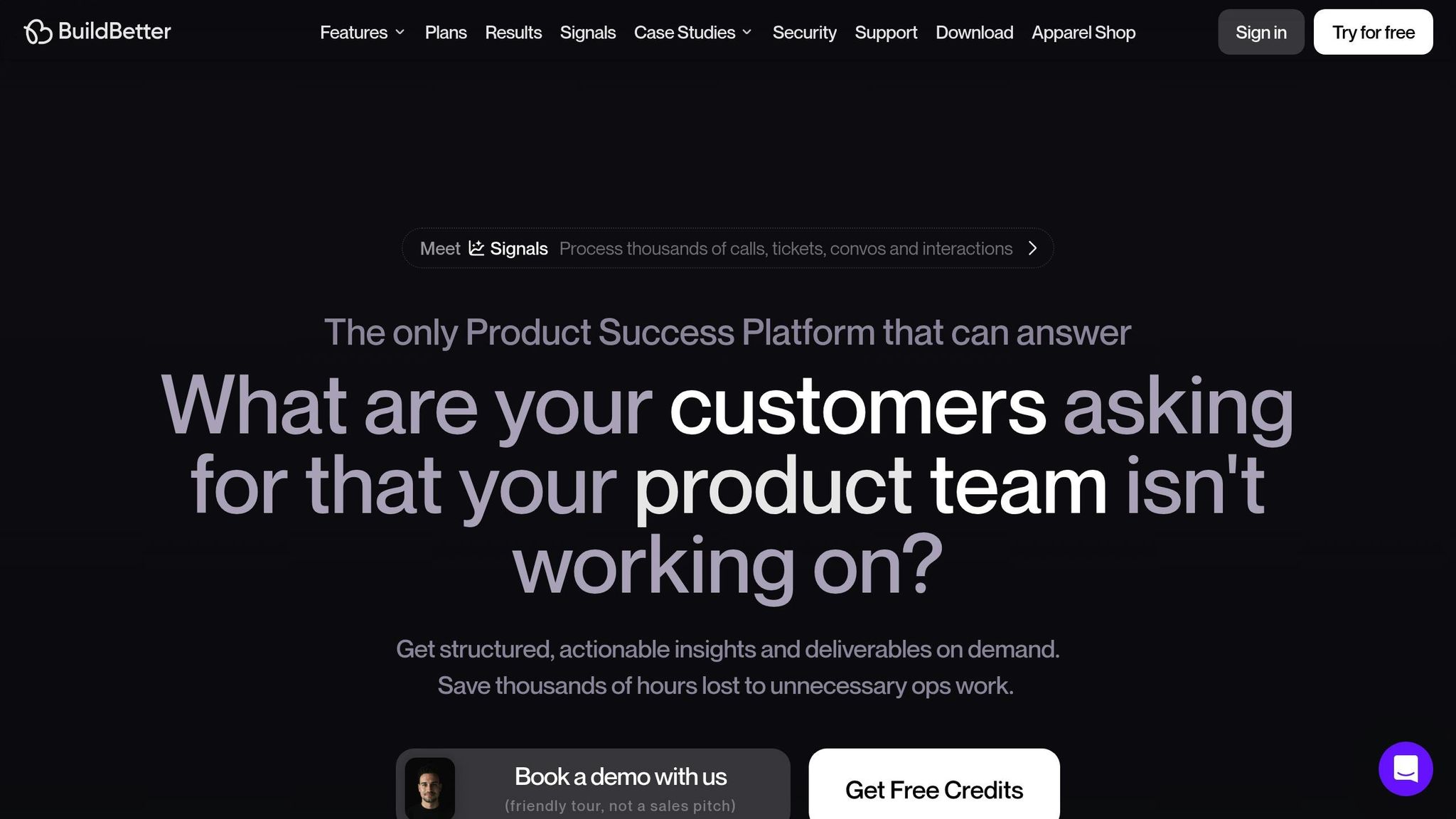
BuildBetter is a platform designed for B2B teams to turn unstructured feedback into actionable insights. With over 100 integrations like Zoom, Slack, and Jira, it consolidates internal communications and customer feedback into one place.
AI-Powered Features
BuildBetter’s AI engine speeds up processes, delivering results up to 10x faster. Key features include:
- Automatically recording and transcribing customer calls
- Extracting key insights from conversations
- Generating detailed documentation
- Filtering feedback by sentiment, keywords, or time periods
- Providing reports on feature requests and blockers
Data Integration and Insights
The platform pulls data from various sources to offer a complete view:
- Internal Communication: Tracks team discussions through calls and Slack.
- Customer Feedback: Analyzes support tickets and surveys to understand customer needs.
- Sales Intelligence: Reviews demo calls to uncover barriers to conversion.
- Product Usage: Monitors feature adoption to measure engagement.
Natural Language Queries
Using natural language processing, BuildBetter allows teams to search their data in plain language. For instance, a product manager could ask, "What features are customers requesting that we aren’t working on?" and get detailed, data-backed answers. This intuitive query system sets BuildBetter apart.
Automated Workflows
Routine tasks are simplified with automation, freeing up teams to focus on strategic goals. BuildBetter uses usage-based pricing (measured in DDUs), making it accessible for teams of all sizes.
Privacy and Security
BuildBetter prioritizes data security and compliance, meeting standards such as:
- GDPR compliance
- HIPAA certification
- SOC 2 Type 2 compliance
- Customizable permission settings
- Secure data encryption
This platform transforms the way teams gather, analyze, and act on feedback.
2. Productboard
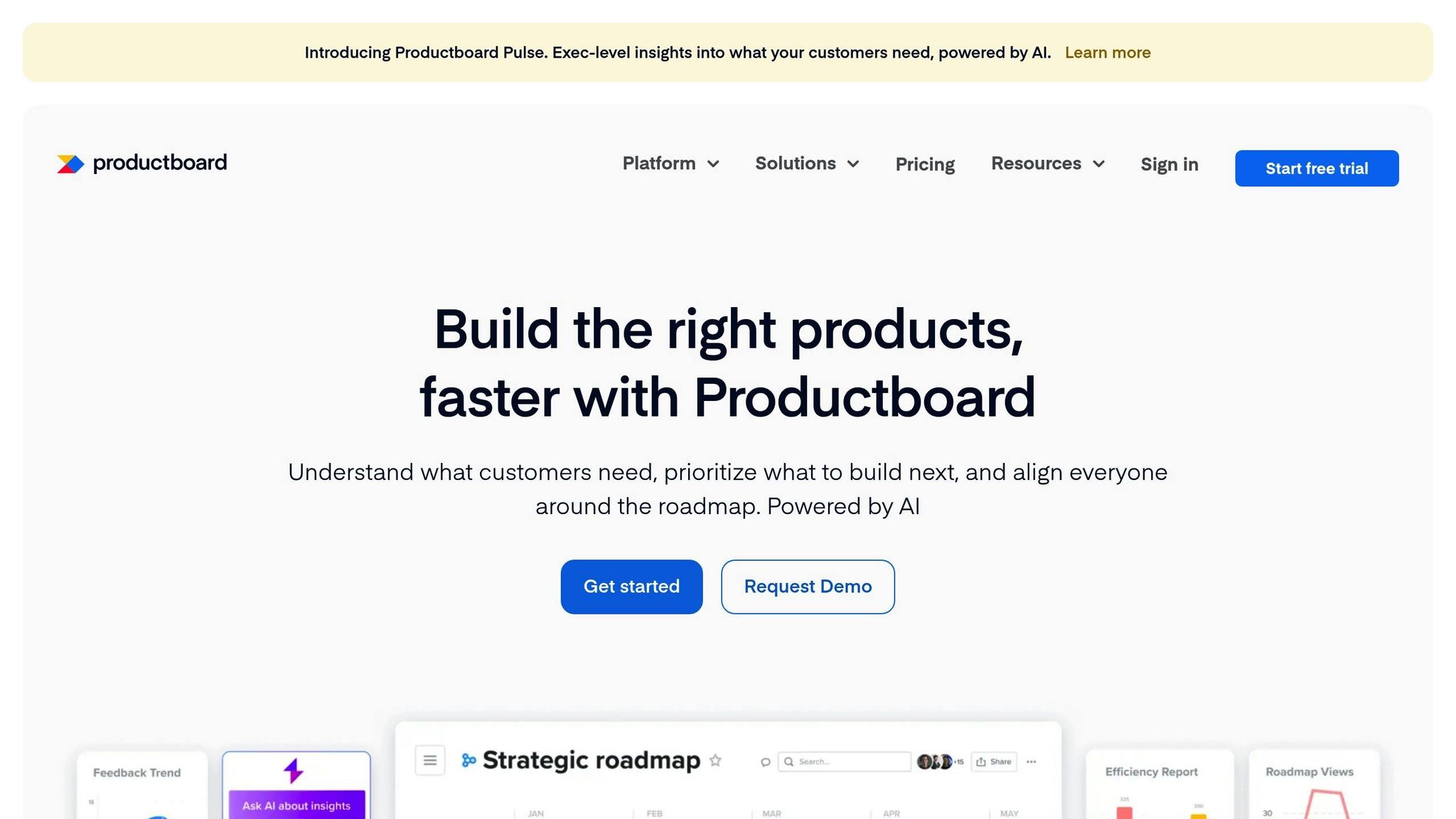
Productboard uses AI to transform how teams manage and analyze customer feedback. It acts as a central platform for gathering and interpreting customer insights.
AI-Driven Analysis
The platform's AI helps teams handle large volumes of feedback efficiently.
"Productboard AI is purpose-built to be a force multiplier for your product teams, drawing upon Productboard data to help you analyze feedback at scale, work faster, and deliver what customers really need".
Managing Customer Feedback
Productboard simplifies feedback management with features like:
- Feedback Portal: Enables direct feedback collection from customers.
- Trend Analysis: Groups feedback to pinpoint emerging patterns.
- Automated Insights: Uses AI to highlight key customer needs.
- Standardized Templates: Makes product workflows more efficient.
Integration Options
The platform integrates with a wide range of tools to enhance its functionality:
| Category | Key Integrations |
|---|---|
| Customer Feedback & Segmentation | Slack, Zendesk, Intercom, Salesforce, Gong |
| Collaboration & Design | Miro, Figma, Mural |
| Development & Delivery | GitHub, Azure DevOps, Trello |
These integrations work seamlessly with Productboard's API capabilities.
API Features
Productboard offers two APIs to streamline workflows:
- Notes API: Collects and organizes product feedback from various sources.
- Features API: Sends prioritized features to development tools for planning.
Insights for Leadership
Productboard Pulse, powered by AI, delivers insights tailored for executives. It helps leaders monitor customer sentiment, set investment priorities, and track feature usage. These insights simplify decision-making throughout the product development process.
3. Qualtrics XM
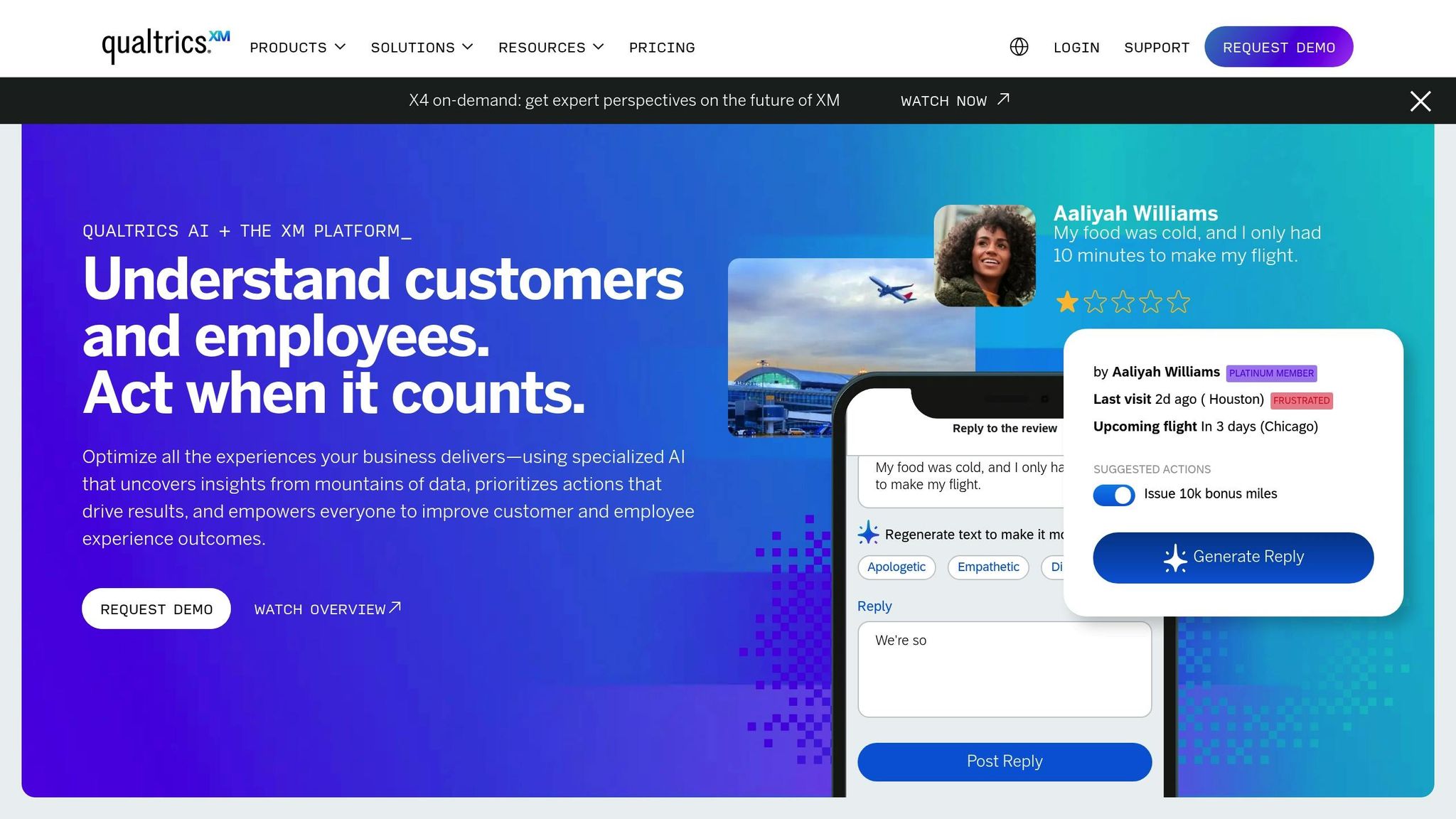
Qualtrics XM helps product teams gather and analyze customer feedback using its AI-powered platform. By combining behavioral and operational data, it provides insights that drive better decisions.
AI-Powered Insights
Qualtrics uses artificial intelligence to process feedback from various channels, offering tools like:
- Conversational Surveys: Designed to uncover deeper insights
- Predictive Analytics: Provides smart recommendations based on data
- Theme Detection: Automatically spots recurring patterns
- Real-time Alerts: Notifies teams instantly when action is needed
"With Qualtrics, the moment we receive feedback we can alert the right teams to take action, to mend those relationships, to solve critical issues in real time with our customers." - Emma Sopadjieva, Head of CX Analytics
These features make it easier to manage and act on customer experiences effectively.
Experience Management Features
The platform stands out for its robust feedback management capabilities, which include:
| Feature Category | Features |
|---|---|
| Data Collection | Multi-channel feedback, Digital interaction tracking, Behavioral data |
| Analysis | AI insights, Predictive recommendations, Theme detection |
| Action Management | Automated alerts, Team notifications, Workflow triggers |
| Integration | ServiceNow connectivity, Compatibility with workplace tools |
Automated Response System
Qualtrics XM simplifies feedback management by processing input instantly, notifying the right teams, generating actionable tasks, and tracking progress. Users have reported a 25% boost in account value.
Enterprise-Wide Implementation
This platform acts as a central hub for managing feedback across an organization. It empowers teams to:
- Identify digital friction: Pinpoint and resolve user experience challenges
- Personalize interactions: Adjust experiences based on customer behavior
- Track customer touchpoints: Monitor and analyze every interaction
- Automate workflows: Make response processes more efficient
By integrating seamlessly with enterprise systems, Qualtrics enhances the way feedback is interpreted and used.
Advanced Analytics
Qualtrics AI dives into both structured and unstructured data to deliver detailed insights. It helps teams better understand customer preferences and predict future needs with tools like:
- Predictive Modeling: Anticipates customer behavior trends
- Sentiment Analysis: Gauges emotional responses
- Trend Identification: Detects new patterns in the market
Trusted by over 20,000 brands, companies such as Hilton rely on Qualtrics to gather and act on guest feedback in real time.
4. Canny
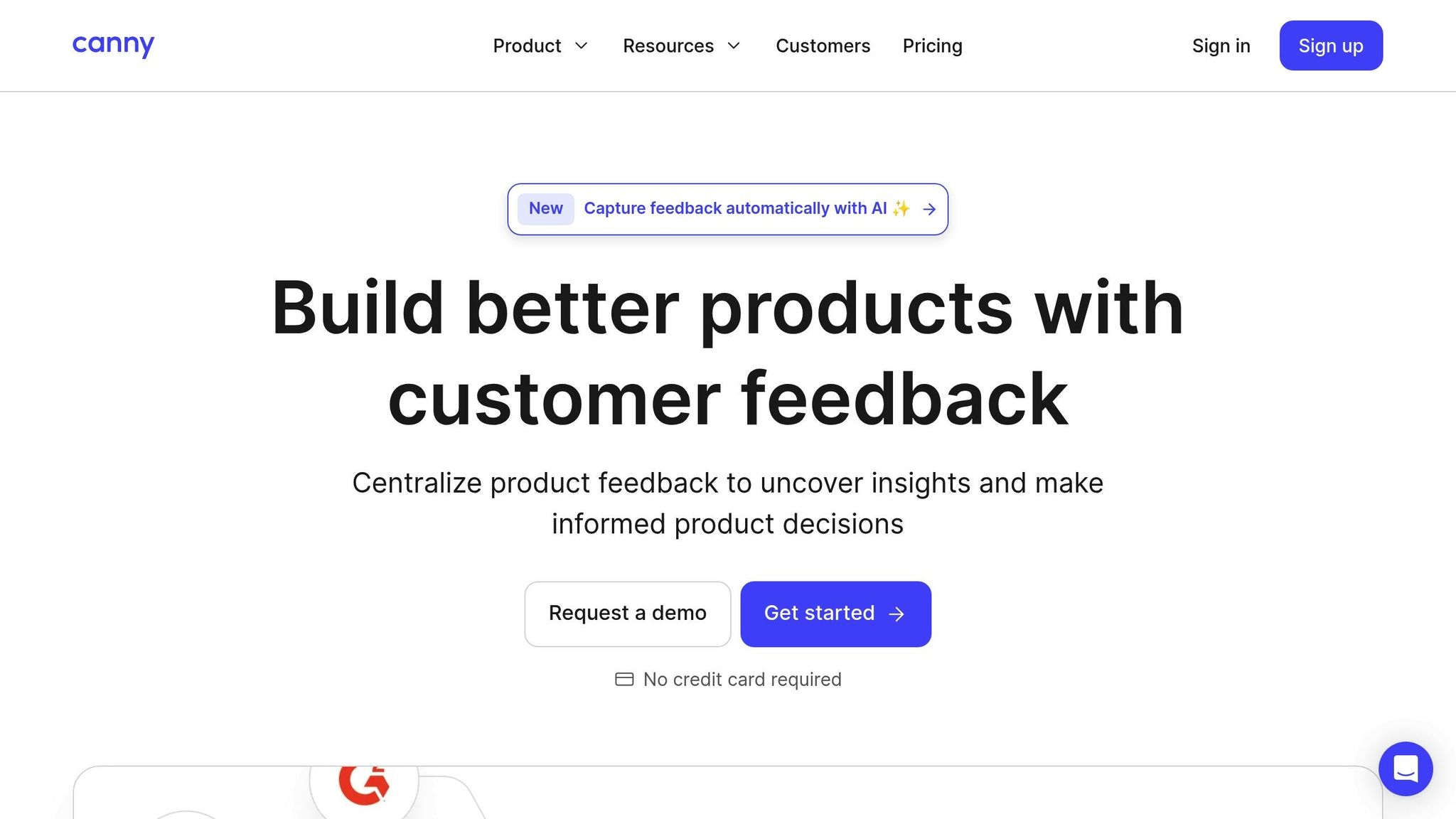
Canny stands out as a feedback platform that prioritizes automation and detailed analytics. Trusted by over 50,000 companies, it simplifies product feedback management. With more than 15 million feedback items logged, it’s a proven tool for handling feedback at scale.
AI-Powered Feedback Management
Canny's Autopilot leverages AI to automate the collection and analysis of feedback. Key features include:
| Feature | Function | Credit Usage |
|---|---|---|
| Feedback Discovery | Scans conversations for feedback | 1 credit per text, 5 per audio |
| Smart Replies | Generates relevant, contextual responses | 1 credit per reply |
| Comment Summarization | Produces concise summaries of feedback | 1 credit per summary |
"Canny's Autopilot ensures feature requests never fall through the cracks. We've seen an 80% increase in requests logged since introducing Autopilot." - Owen Doherty, COO
Workflow Integration
Canny works seamlessly with existing tools, cutting down inbox clutter by 20%, saving product marketing teams 2–3 hours per week, and improving sales teams' ability to track feature requests.
Advanced Analytics and Prioritization
The platform’s analytics help teams make better product decisions. Customizable prioritization formulas let businesses align feedback with their goals and revenue potential.
"Thanks to Canny, we find the issues that are most requested, avoid churn, and generate more revenue." - Jay Patel, Product Manager
Community Engagement Features
Canny also promotes user engagement with tools that simplify feedback collection and communication:
| Feature Category | Capabilities |
|---|---|
| Feedback Collection | Multi-channel input, automated categorization |
| User Communication | Public/private roadmaps, changelog updates |
| Collaboration | Team discussions, stakeholder involvement |
| Progress Tracking | Status updates, milestone monitoring |
Enterprise-Grade Security
Canny ensures data privacy and security with SOC 2 Type 2 compliance. Key security measures include:
- Avoiding customer data use for AI training
- Offering secure authentication options
- Enforcing strict data protection policies
"It just makes our lives easier from the product perspective, to be able to go to this one tool and see everything." - Liya Ai, Product Operations Manager
Scalable Solution
Canny is built to grow with your team. Start with the basics and expand as your needs evolve, making it a practical choice for teams of all sizes.
5. Zeda.io
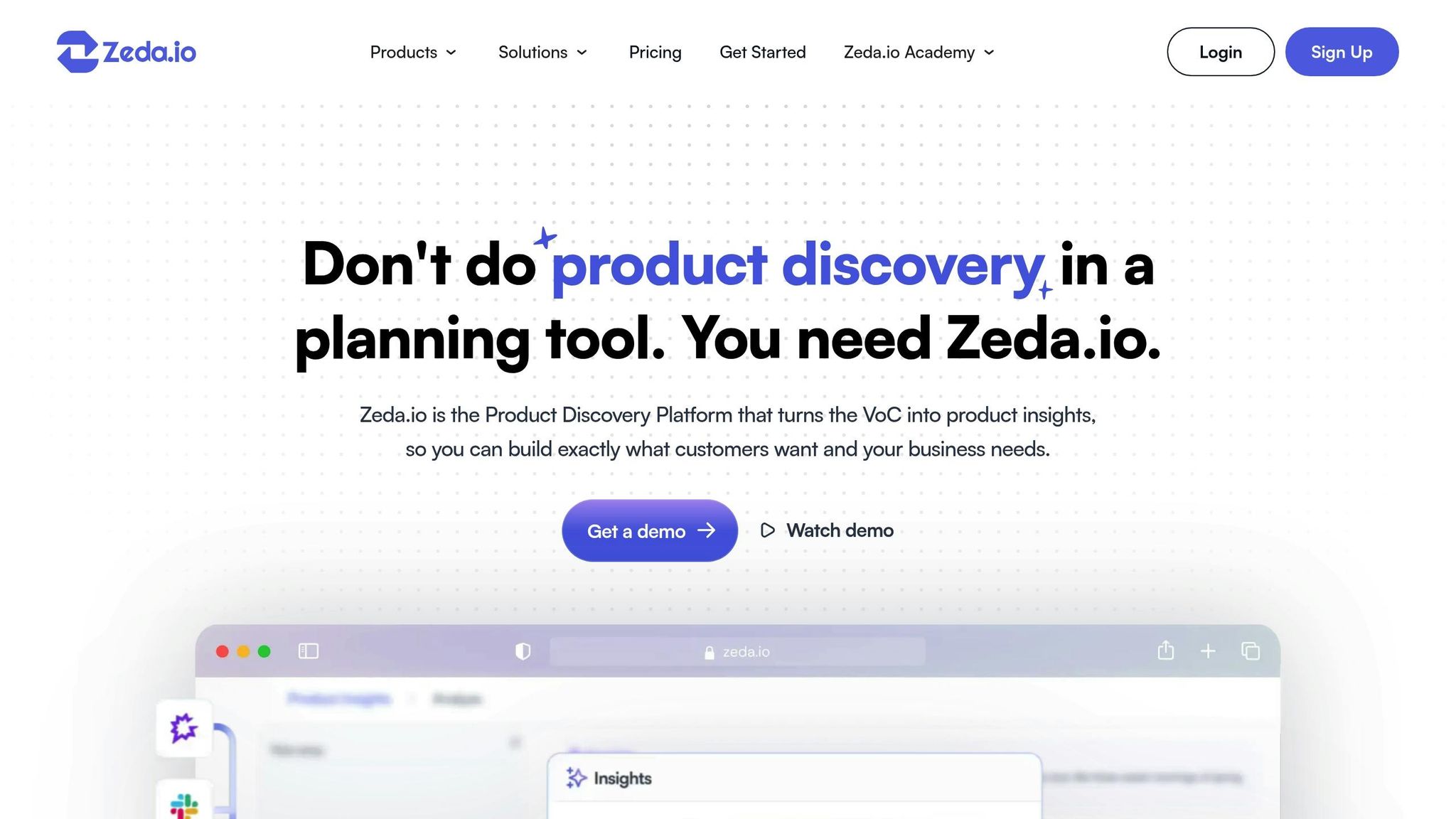
Zeda.io uses AI to turn Voice of Customer (VoC) data into actionable insights, helping reduce churn by up to 20% and saving over 90 hours of work.
AI-Powered Analysis
The platform excels at collecting and analyzing feedback from various sources. Its AI-driven features include:
| Feature | Purpose | Impact |
|---|---|---|
| Ask AI | Validates ideas using customer data | Speeds up product strategy |
| Opportunity Radar | Predicts trends and issues | Boosts sales growth by 50% |
| Insight Reports | Breaks down feedback by source and segment | Evaluates revenue impact |
"Zeda.io is an intuitive AI platform that empowers teams to enhance their product development by gaining deeper insights into customer desires." – Aaron Lopez, Senior Product Manager at Branch
Enterprise Integration Hub
Zeda.io integrates with over 5,000 apps, simplifying feedback management across multiple channels. It consolidates data from key sources like:
| Data Source | Analysis Capabilities |
|---|---|
| GTM Data | Assesses revenue impact |
| User Interviews | Extracts critical insights |
| Product Analytics | Identifies usage patterns |
| Survey Responses | Detects emerging trends |
These integrations create a unified system for managing workflows.
Workflow Optimization
Zeda.io uses its integrations to streamline processes by converting AI-generated insights directly into development tickets. Key enterprise features include:
- Custom reporting and analytics
- Dedicated migration support
- Health checks and audits
- Dedicated account management
"If you want to redesign your feedback loop to extract concrete customer insights in no time, then there is absolutely no other tool like Zeda.io." – Rahul Shah, Senior SVP & GM at Marqeta
Advanced Customer Intelligence
Its AI engine processes customer feedback to deliver detailed insights, focusing on:
- Feedback source attribution
- Customer segment analysis
- Revenue impact evaluation
Tool Comparison
This section breaks down the main differences between BuildBetter and Canny, based on the detailed reviews above.
Core Capabilities Comparison
| Feature | BuildBetter | Canny |
|---|---|---|
| AI Analysis | Advanced B2B-focused analysis | Smart replies & summaries |
| Data Sources | 100+ integrations - including internal communications | Centralizes all customer feedback |
| Integration Depth | Native integrations with Zoom, Teams, Slack, and Jira | Integrates with customer service tools |
| Pricing Model | Starting at $7.99/month | N/A |
These distinctions provide a foundation for understanding their ease of integration and overall return on investment (ROI), which are explored further below.
Specialized Strengths
BuildBetter stands out for its ability to handle both internal and external unstructured data, making it highly useful for B2B product teams. Its wide range of integrations - connecting with tools like Salesforce, Zendesk, and HubSpot - offers a complete view of critical feedback. These capabilities enhance feedback management, as detailed in earlier sections.
Canny, on the other hand, has processed over 15 million feedback items and supports more than 50,000 registered companies.
"Canny is saving us about 2-3 hours per week on product marketing. Instead of going back and forth between various tools, everything lives in Canny now. It's our one source of truth."
– Michaela Rollings, Head of Brand & Content
Integration Capabilities
Streamlined workflows depend on effective integrations:
- BuildBetter: Works seamlessly with Zoom, Teams, Slack, and Jira.
- Canny: Connects to tools like Intercom, Jira, and HubSpot, centralizing customer feedback for quick access.
Efficiency and ROI
Here’s how these tools improve productivity and impact users:
| Tool | Time Savings | User Impact |
|---|---|---|
| BuildBetter | 15+ hours saved per month (Starter plan) | Better collaboration and clearer decisions |
| Canny | Saves significant support time | 20% reduction in support workload |
Security and Compliance
Security is a critical factor for both tools. BuildBetter adheres to key standards like GDPR, HIPAA, and SOC 2 Type 2, and includes custom SSO/SAML options. These measures ensure that teams can securely manage feedback from both internal and external sources while maintaining strict data protection protocols.
Choosing the Right Tool
When selecting a product feedback tool, focus on what works best for your team. Here are the key factors to consider:
-
Team Size and Needs
For small teams (fewer than 10), look for tools that offer basic feedback collection and core integrations. Mid-sized teams (10–50) may need advanced analytics and support for multiple workflows. Larger organizations (50+) often require stronger security features, custom authentication options, and dedicated support. -
Integration Capabilities
Choose tools that easily connect with your current tech stack. Popular platforms like Salesforce, Zendesk, and HubSpot are examples of integrations to prioritize. -
Budget Considerations
Factor in both upfront costs (like implementation and training) and ongoing expenses (per-user fees or flat rates). Also, consider the time and productivity benefits. For instance, BuildBetter's Starter plan, priced at $7.99/month, can save teams over 15 hours of work each month - ideal for those formalizing their feedback processes. -
Security Features
If you handle sensitive customer data, prioritize tools with strong security credentials. Look for compliance with standards like GDPR, HIPAA, and SOC 2 Type 2, as well as features like custom SSO/SAML for secure access. -
Use Case Fit
Match the tool to your primary goal. For product development, pick one with feature prioritization and integration with development platforms. For customer success, focus on tools that organize feedback from multiple channels. For research, opt for platforms offering advanced AI analysis and detailed reporting.